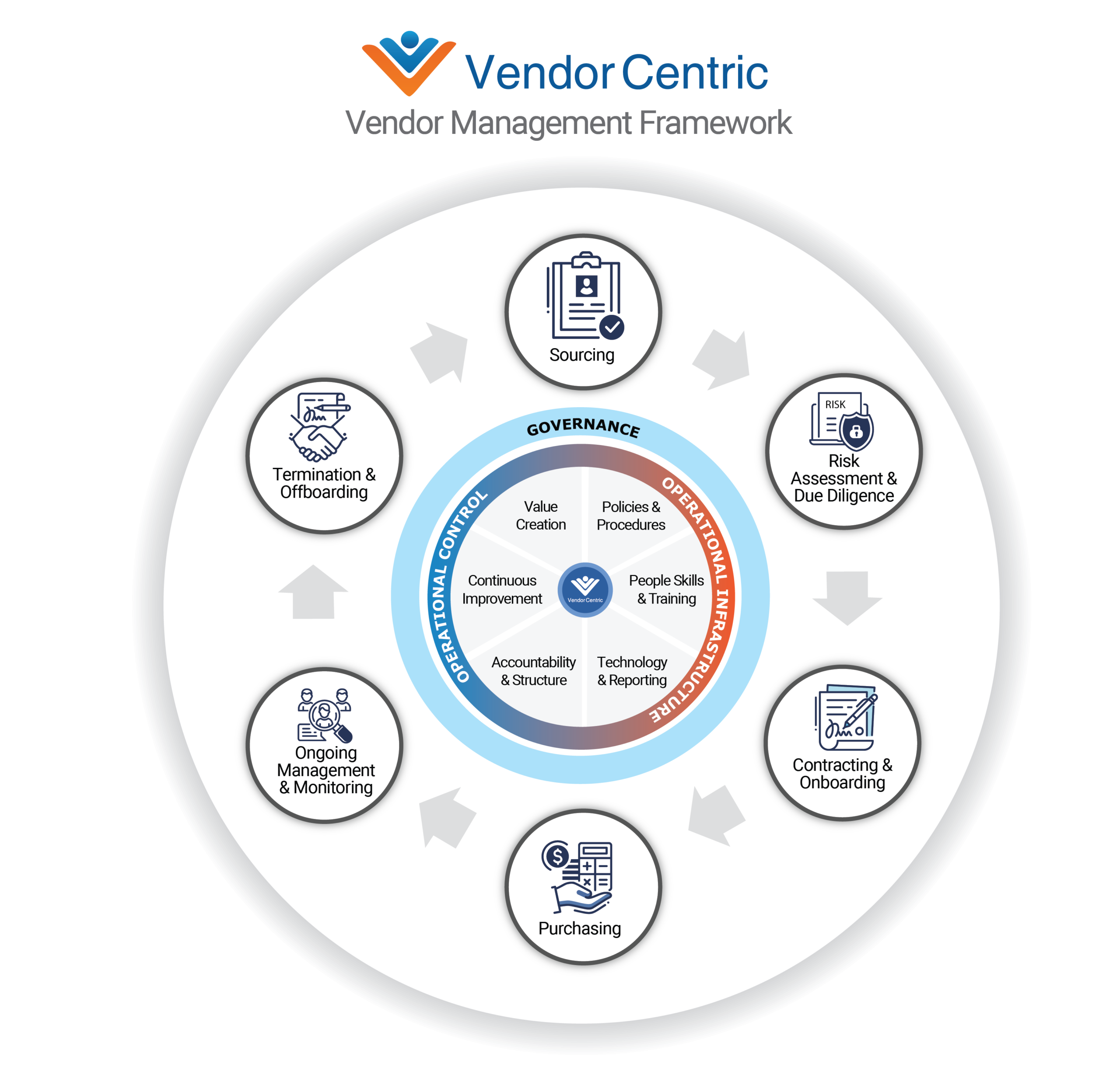Looking for a clear and succinct definition that will help you explain ‘what is vendor management’ to your colleagues, senior management and even your Board? You’ve come to the right place.
The adoption of vendor management as a business discipline is growing rapidly, fueled by the need to:
- meet mandates from regulators, auditors and customers
- modernize & scale operations for procurement, contract management and third-party risk, and
- stabilize the business and ensure continuity during supply chain disruptions and geopolitical unrest.
Boards, auditors, regulators, and customers are all pushing for standardized, effective vendor management practices. The types of practices that improve cost control, risk mitigation, business continuity and compliance with a growing list of regulatory requirements.
Staff are pushing too. A growing number are operating in a more remote and decentralized environment. They want clearer policies and simpler processes so they can quickly find and work with vendors they need in their day-to-day business.
But what exactly is vendor management? The answer is simple – and complex. Here’s what I mean.
What is vendor management?
Vendor Centric’s definition of vendor management is based on years of practical, hands-on experience helping companies establish, implement and optimize their vendor management programs. Here’s how we sum up the meaning:
“Vendor management is a corporate business function whose purpose is to ensure vendor relationships are holistically managed so that more value, and less risk, is created for the enterprise.”
One of the things that makes the vendor management function unique from other business functions like accounting or marketing is that it isn’t isolated to a single department. Rather, it’s a coordinated effort between the three operational areas that, collectively, support nearly every aspect of vendor lifecycle management.
- Procurement Management – finding and sourcing vendors
- Contract Management – executing and managing contracts
- Third-Party Risk Management – assessing and monitoring risk with vendors and other third parties

In essence, the vendor management function is the ‘quarterback’, providing strategic guidance, coordination and infrastructure necessary to get all three operational areas and vendor management activities working in harmony. However, the function needs structure for everything to work harmoniously. That’s where the vendor management framework comes into play.
The Importance of a Vendor Management Framework
Like with any business discipline, there are fundamentals you need to follow – you can’t make them up as you go along. The purpose of a vendor management framework is to provide a blueprint for the practices and infrastructure needed to holistically manage vendors from start to finish.
Vendor Centric’s Vendor Management Framework is comprised of two main sections. The first section (the outer ring) defines the six stages of the vendor lifecycle that need to be managed over the course of your relationship.

- Sourcing
Identify and select the right vendor(s) to meet corporate sourcing requirements. - Risk Assessment & Due Diligence
Evaluate and mitigate potential risks before entering a contract. - Contracting & Onboarding
Negotiate high-value, low-risk contracts and integrate vendors into your operations. - Purchasing & Vendor Management
Buy the goods and services you need through efficient purchasing and spending control. - Ongoing Management & Monitoring
Manage vendor performance and compliance and monitor and mitigate risks. - Termination & Offboarding
Formally end and ‘de-risk’ the relationship.
The second section (the inner circle) defines the governance needed to align your people, processes, and systems to provide effective and efficient vendor management across all lifecycle stages.
- Policies & Procedures
Establishes the overarching rules, guidelines, activities and operational controls for vendor management. - People, Skills & Training
Ensures the right level of vendor management resources, subject matter expertise and stakeholder knowledge. - Technology & Reporting
Centralizes data, facilitates workflow, provides reporting and ensures an audit trail of activities. - Accountability & Structure
Defines the governing body and establishes the control structure to provide
oversight and accountability. - Continuous Improvement
Ensures operations are continuously improved for efficiency, scale and alignment with changing business priorities and regulations. - Value Creation
Aligns vendor management with strategic priorities, and creates value through cost savings, risk reduction, performance improvement and innovation.
The scope of your vendor management function should always scale to your organization’s requirements, size, and overall risk appetite. But all components of the vendor management framework need to be in place for the function to be effective.
Risk-Based Approach to Vendor Management
Another important concept to better understand the meaning of vendor management is recognizing that not all vendors are created equal when it comes to how they need to be managed. Some relationships are large and complex, while others are small and transactional.
That’s why the best practice is to employ a risk-based approach to vendor management. Taking a risk-based approach allows you to focus your time and energy on the riskiest – and oftentimes most important – vendors to your organization. Here’s what I mean.
When you enter a new relationship with a vendor, they bring a variety of potential risks into your organization such as:
- Operational & business continuity risk
- Information security risk
- Financial risk
- Legal and compliance risk
- Reputational risk
- Plus many others
Identifying and mitigating these risks BEFORE you sign a contract, and monitoring (mitigating) them throughout the life of the relationship, is the key to risk-based vendor management.
Operationalizing a Vendor Management Business Function
If you’re just getting started with vendor management, establishing a new business function within your organization doesn’t happen overnight. But you can get traction quickly by taking a practical, risk-based approach to building your vendor management program.
Here are three phases you can follow.
Phase 1: Baseline Current Operations and Set Priorities
There is no ‘one size fits all’ when it comes to vendor management. The size and complexity of your program needs to align to your individual goals, priorities and resources.
Start your journey by defining your near-, mid- and long-term vendor management priorities across all stages of the lifecycle. Then baseline your current operations to evaluate the strength of your current infrastructure and the gaps you’ll need to close. This enables you to determine the level of effort to get your program off the ground, and create a roadmap for building and operationalizing your program.
Phase 2: Create Your Governance Infrastructure
Next up is building out your program fundamentals – your vendor management governance. This includes:
- Vendor management policies and procedures
- Resources, roles and responsibilities
- Vendor management technology and reporting
You also need to establish a control structure with accountability. This ensures there is an Executive Owner assigned to manage the function, and that there is an effective structure for control, escalation, and accountability.
Phase 3: Operationalize Your Vendor Management Program
Finally, once your fundamentals are established, you’re ready to operationalize your program. It’s important to provide orientation and training to all key stakeholder groups, and to monitor adoption in the early stages of the process.
Once your vendor management function is up and running, the real magic happens when you start creating ‘quick wins’ that demonstrate real, measurable value from your vendor management activities. This includes things like:
- Generating cost savings
- Improving vendor performance
- Avoiding unwanted contract renewals
- Reducing third-party risk
- Meeting audit and regulatory requirements
So What is the Meaning of Vendor Management?
As I stated at the outset, the meaning of vendor management is both simple and complex.
At a high level vendor management is a structured program for managing an organization’s relationships with vendors to generate value and mitigate risk.
More precisely, vendor management means effectively aligning people, processes and systems organization-wide to function cohesively in a clear framework that can holistically scale and evolve according to your ongoing risk mitigation and value creation priorities.
If you’re interested in learning more about vendor management, we have a variety of free resources and over 100 blogs on the topic.
If you’re looking to get a new vendor management program up and running, download our free Kick-Start Guide which includes a practical playbook for building a scalable program to create long-term value.



















 Tom is a trusted advisor on procurement and third-party management to organizations across the United States. Having worked with over 120 organizations over his 30-year career, he has a unique ability to bring creativity and discipline to finding solutions for even the most complex challenges his clients face.
Tom is a trusted advisor on procurement and third-party management to organizations across the United States. Having worked with over 120 organizations over his 30-year career, he has a unique ability to bring creativity and discipline to finding solutions for even the most complex challenges his clients face.



